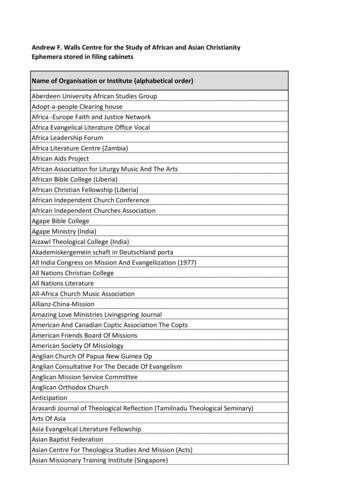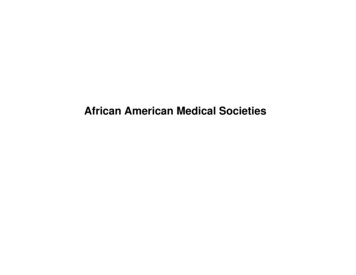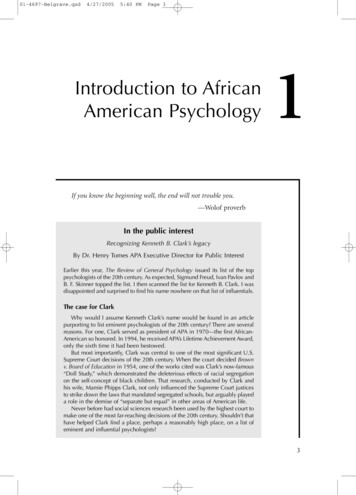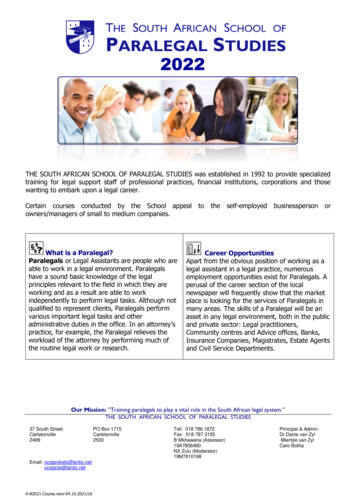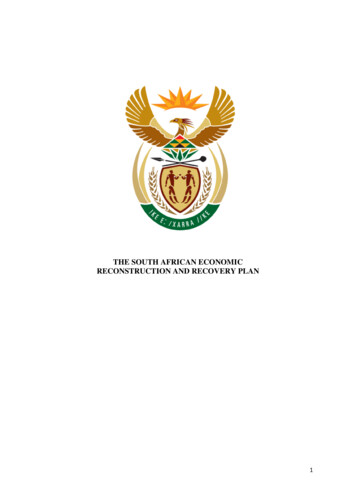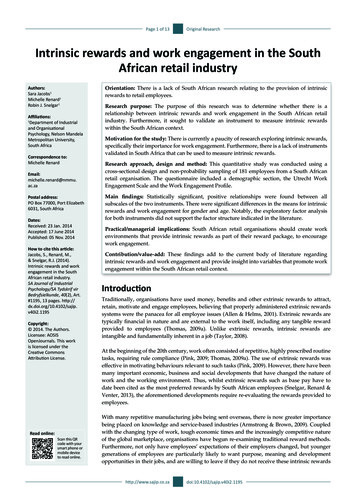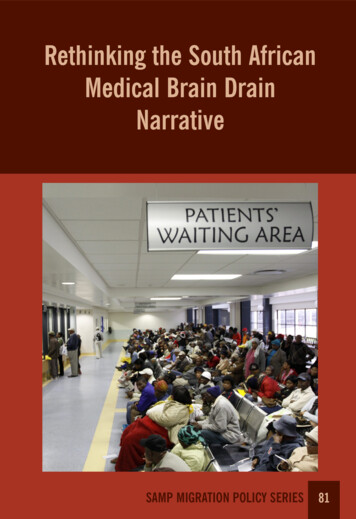
Transcription
Rethinking the South AfricanMedical Brain DrainNarrativeSAMP MIGRATION POLICY SERIES81
Rethinking the MedicalBrain Drain NarrativeJonathan CrushSAMP MIGRATION POLICY SERIES NO. 81Series Editor: Prof. Jonathan CrushSouthern African Migration Programme (SAMP)2019
AUTHORJonathan Crush is Professor at the Balsillie School of International Affairs, Waterloo,Canada, and Extraordinary Professor at the University of the Western Cape, Cape Town,South Africa. Southern African Migration Programme (SAMP) 2019Published by the Southern African Migration Programme, International MigrationResearch Centre, Balsillie School of International Affairs, Waterloo, Ontario, Canadasamponline.orgFirst published 2019ISBN 978-1-920596-45-3Cover photo by Gallo Images/Daily Sun/Lucky MorajaneProduction by Bronwen Dachs Muller, Cape TownPrinted by Print on Demand, Cape TownAll rights reserved
CONTENTSPAGEExecutive Summary1Introduction3Temporary Medical Migration6Methodology10Mobile Medical ion Policy Series29LIST OF TABLESTable 1: Top Source Countries for Permanent and Temporary Health Professionals7in Australia, 2005/2006 to 2009/2010Table 2: Doctors Working Temporarily in Canada Under TFWP8Table 3: Other Countries of Employment of South African Doctors12Table 4: Period Spent Working in Another Country12Table 5: Main Reasons for Returning to South Africa13Table 6: Comparison of Satisfaction with Working Conditions18Table 7: Comparison of Satisfaction with Living Conditions19Table 8: Satisfaction with Government Policies20Table 9: Likelihood of Permanent Emigration by Migration Status20
migration policy series no. 81EXECUTIVE SUMMARYConcerns about the negative impact of the “brain drain” of health professionals from Africahave led to a dominant narrative in which those who migrate are a permanent, and costly,loss to the country of origin and a permanent, and valuable, gain for the country of destination. This brain drain narrative has a powerful hold on the way in which the migration of doctors is conceptualized and measured and its impacts are understood. Nationaland international policy responses are similarly premised on the notion that all forms ofcross-border migration are advantageous to destination countries in the Global North anddamaging to health outcomes in origin countries in the Global South. South Africa is oftenseen in the migration literature as an archetypal African medical “brain drain” story. Thepost-apartheid departure of graduates from South Africa’s medical schools has even beenlabelled “brain flight” and “brain haemorrhage” and a “deepening crisis” for the country’shealth system. Although some have contested the idea of a brain drain in specialisms suchas surgery, the country’s brain drain narrative has proven remarkably durable and continues to frame policy responses to the South African health care system.In the new world of transnationalism, a global skills market, and greatly increased mobility by health professionals, it is unlikely that the traditional permanent-exodus model of thebrain drain narrative adequately captures all forms of migration by South African doctors.Recent surveys suggest that a significant minority of doctors have experience working outside the country. To understand this finding, it is important to situate the experience ofSouth Africa’s physicians in the context of the opportunities that exist within destinationcountries in the Global North and Gulf States for the temporary employment of doctors.Global data on the temporary migration of doctors is scarce but there is enough evidenceto test the dominant narrative that all doctor migration is permanent and therefore, bydefinition, harmful.This report first examines the temporary employment opportunities for South Africandoctors in countries such as the United Kingdom, Ireland, Canada, and Australia. Theseinclude residencies, fellowships, locums, and various temporary worker programs. A 2013SAMP survey of out-of-country employment found that nearly half of the South Africandoctors who completed the survey had worked in at least one other country. Fifteen percenthad worked in at least two other countries. Some had worked in three or more countries,with a maximum of seven countries. As many as 61% of those with work experience outsideSouth Africa had been to the United Kingdom. Canada was second at 10%, followed by1
rethinking the south african medical brain drain narrativesome European countries combined (including Germany, the Netherlands, and Belgium)at 9%, Ireland (9%), and Australia and New Zealand (both 6%). Around 5% had worked innewer destinations such as the United Arab Emirates and Saudi Arabia. Most doctors whogo overseas to work do so temporarily and for a limited period. Some 80% had worked intheir first overseas country of employment for three years or less. Their reasons includedfinancial inducements (including paying off student debts) and a desire to gain furthertraining and skills. The main reasons for return were that their overseas job was temporary,that they had a permanent job in South Africa, and that they preferred being in SouthAfrica for family and lifestyle reasons.Given that many South African doctors have emigrated permanently over the last threedecades, it is important to know whether those who have experience working temporarily outside the country are more or less likely to leave permanently in the future. The finalsection of the report therefore compares the emigration intentions of migrants (those whohave worked outside South Africa) and non-migrants (those who have not). Only 50% ofthe respondents who had worked in a foreign country said that return to South Africa waspermanent, which suggests that continued temporary or permanent migration is a strongpossibility for many. Migrant doctors have marginally higher satisfaction levels with SouthAfrican working and living conditions than non-migrants. At the same time, their overalllevels of dissatisfaction are very high. This translates into significant and greater emigrationpotential among migrants. For example, 46% of migrants said they have given a great dealof consideration to emigration, compared with only 36% of non-migrants. Migrants alsoindicated that there was a greater likelihood of leaving than non-migrants. One-third ofmigrants and 26% of non-migrants said the likelihood of leaving within two years was high.At the five-year mark, the percentages were 52% and 48% respectively.The report draws two major conclusions: first, the dominant brain drain narrative overlooks the complex nature of South African physician migration and ignores the fact that asignificant number of doctors have temporary employment experience outside the country.Second, it suggests that temporary employment overseas increases the chances of permanent emigration later. The brain drain narrative needs to be rethought but it cannot be jettisoned. All South African doctors, migrant and non-migrant, still display extremely highpermanent emigration potential. To date, government has failed to produce solutions tothis intractable problem. Indeed, whatever the merits of recent policy initiatives to makehealthcare more accessible to the population, there are indications that they will exacerbaterather than mitigate the brain drain.2
migration policy series no. 81INTRODUCTIONA recent review of studies of health professional migration in a globalized context notedthat “the opportunities of health workers to seek employment abroad has led to a complex migration pattern, characterized by a flow of health professionals from low-income tohigh-income countries.”1 As a result, recruiting doctors and nurses from a low or middleincome country to serve the demand in high-income countries “effectively creates a shortage in the country of origin, and hence contributes to worse health outcomes.”2 Like most ofthe literature they review, their premise is that health professional migration is a zero-sumgame, i.e. those who migrate are a permanent, and costly, loss to the country of origin and apermanent, and valuable, gain for the country of destination. This brain drain narrative hasa powerful hold on the way migration of doctors is conceptualized and measured and itsimpacts are understood. National and international policy responses are similarly premisedon the notion that all forms of cross-border migration are advantageous to destinationcountries in the Global North and damaging to health outcomes in origin countries in theGlobal South.An analysis of the financial cost of doctors emigrating from various African countriesto Australia, Canada, the United States, and the United Kingdom concluded that the costto Africa in lost investment in training amounted to USD2 billion.3 The study was criticized by one researcher as “unscientific”, “indefensible” and “profoundly flawed.”4 One ofthe many objections was the failure to discount the value of remittances and to “assumezero economic effects from African doctors’ remittances.”5 In particular, African doctors inthe United States and Canada supposedly remit at least double the cost of their education totheir home countries. Whatever the relative merits of these opposing arguments, they shareone thing in common: an assumption that migration of doctors from Africa is a one-way,permanent move and that calculation of costs and benefits should be based on a model ofpermanent settlement in countries of destination.South Africa is often seen in the migration literature as an archetypal African medicalbrain drain story.6 The post-apartheid departure of graduates from South Africa’s medical schools has even been labelled “brain flight” and “brain haemorrhage” and a “deepening crisis” for the country’s health system.7 Although some have contested the idea of abrain drain in specialisms such as surgery,8 the brain drain narrative has proven remarkablydurable and continues to frame policy responses to the underperforming South African3
rethinking the south african medical brain drain narrativehealth care system. The narrative has several key elements. First, because data on emigration from South Africa is notoriously unreliable, the story begins with statistics collectedby destination countries and collated by organizations such as the Organization for Economic Cooperation and Development (OECD). For example, OECD data suggests thatthere are more than 8,000 South African-trained doctors in OECD countries, with themajority in Canada, Australia, the United Kingdom, the United States, New Zealand, andIreland.9 Smaller numbers are recorded in countries such as Israel, Belgium, Switzerland,and Germany. South African doctors are supposedly actively recruited and eagerly receivedin many countries for the quality of their training and expertise.10Second, the brain drain narrative is underpinned by attitudinal surveys of the emigration potential of practising and trainee physicians, as well as the retrospective views ofthose who have already emigrated.11 SAMP’s 2013 online survey of South African doctors,for example, found that 40% had given emigration a great deal of thought and only 15%had never thought about it.12 In addition, 40% had given it more consideration in the previous five years, while only 18% had given it less. Some 29% said they were likely to emigratewithin two years and 50% within five years, while 51% had registered or written licensingexaminations with an overseas professional body. Similarly, a survey of over 800 final-yearstudents at eight South African medical schools found that 55% planned to work abroadafter graduation.13 A more recent survey of 260 students at three South African medicalschools found that three-quarters had given some or a great deal of consideration to leaving South Africa.14 Despite holding strong opinions about the negative consequences ofphysician out-migration for South Africa, one-quarter said it was likely they would leavewithin two years of qualification and 58% that it was likely within five years. A 2011 surveyof first and final-year health sciences students at three South African universities (CapeTown, KwaZulu-Natal, and Limpopo) found that just over half intended to work in anothercountry.15 Finally, a study of final-year medical students in six African countries foundthe highest levels of interest in emigration among South African students.16 Whether highemigration potential translates into actual departure depends on a number of factors but inthe narrative, a large number of doctors are primed to leave and the brain drain is boundto continue.A third component of the brain drain narrative is that push rather than pull factors aredriving the permanent exodus of doctors from the country. Attitudinal surveys all tell thesame story that there is extreme dissatisfaction with workplace and living conditions in4
migration policy series no. 81South Africa, which explains both the very high levels of emigration potential and departure itself.17 The 2013 SAMP survey, for example, found that 63% of doctors were dissatisfiedwith their remuneration, 82% with their fringe benefits, and 90% with the taxes they hadto pay.18 In the workplace, 71% were dissatisfied with their relationship with management,58% with their workload, 54% with personal security, and 48% with workplace morale.As regards living conditions in the country, 92% were dissatisfied with the prospects fortheir children, over 90% were dissatisfied with their personal and family safety, and 80%were dissatisfied with the cost of living. A more recent survey of over 2,000 doctors by theColleges of Medicine of South Africa (CMSA) reported that “the most significant reasongiven by doctors for why they would choose to emigrate was personal and family safety andsecurity.”19 In June 2018, the Minister of Health tabled a National Health Insurance (NHI)Bill in Parliament that will precipitate major changes in the way in which both private andpublic healthcare are delivered in the country.20 One survey of healthcare workers’ attitudestowards the NHI found overwhelmingly negative and sceptical sentiments, with over 80%of the opinion that the NHI would cause more emigration and half saying it would leadthem personally to leave.21 Alarmist media speculation is that the brain drain will accelerateeven further with its implementation.22The fourth strand in the brain drain narrative is that past policy measures and retentionstrategies to mitigate the brain drain have been unsuccessful.23 The adoption of the WHOGlobal Code of Practice on the International Recruitment of Health Personnel was meantto slow the brain drain but has had little obvious impact on the outflow of doctors fromAfrica, as the numbers continue to rise in major destinations such as the United States, theEuropean Union, Canada, and Australia.24 As a result, “the current suite of retention strategies are either failing and/or targeting the wrong factors.”25 And, far from slowing the braindrain, government policies towards the sector are seen as a major factor driving it.The final aspect of the brain drain narrative is that South Africans who have emigratedare a disengaged diaspora. A study of the medical diaspora in Canada found that, despitethe perpetuation of a South African cultural identity, South Africa itself was often seen asa racial dystopia.26 The study found minimal interest in supporting development initiatives and relatively low levels and volumes of remitting. Also, surveys of South Africans inCanada and other countries have shown that South Africans have very little inclination toengage in classic forms of return migration.5
rethinking the south african medical brain drain narrativeIn the new world of transnationalism, a global skills market, and greatly increasedmobility by health professionals, it is inherently unlikely that the traditional, uni-directional, permanent settlement model of the brain drain narrative adequately captures allforms of migration by South African doctors. This report attempts to re-examine the narrative and the evidence for more complex forms of mobility. In order to do this, it is important to situate the experience of South Africa’s physicians in the context of the opportunitiesthat exist within destination countries for the temporary employment of doctors. The nextsection of the report therefore reviews the surprisingly limited literature on the temporary employment of migrant doctors in several countries. The ensuing sections turn to theSouth African case, beginning with a description of the methodology and data on whichthe report is based. The findings on temporary migration that emerge from the research arethen discussed. The final section returns to the issue of the brain drain narrative by asking ifthere are differences in the emigration potential of South African doctors who have experience working outside the country and those who do not.TEMPORARY MEDICAL MIGRATIONGlobal data on the temporary migration of doctors is virtually non-existent but it is certainly necessary to test the dominant narrative that all doctor migration is permanent andtherefore, by definition, harmful. There are hints in various destination countries that thetemporary migration of South African doctors is an important phenomenon that needsfurther study. For example, Ireland has become an increasingly important destination fordeparting South African doctors. Yet the World Health Organization (WHO) reports thatonly 20% of South African doctors registered in Ireland practice exclusively in that country,which raises the obvious question about where the other 80% might be. Ireland is certainlya stepping stone to other destinations and experiences its own brain drain, which probablyexplains some of this discrepancy.27 One survey of foreign-trained doctors in Ireland foundthat 23% planned to return to their home country and 47% intended to migrate onwards.28There is, therefore, a strong possibility that the missing 80% are now back in South Africa,have moved on to other countries, or are practising in both Ireland and South Africa.The OECD puts the total number of South African-trained doctors in the United Kingdom at fewer than 2,000, yet the General Medical Council has over 7,000 South Africanmedical graduates registered to practise. This discrepancy implies that there are many more6
migration policy series no. 81South African doctors registered in the United Kingdom than are practising there on afull-time or ongoing basis. A recent report on doctor migration to Australia, another majorSouth African destination, distinguishes between permanent and temporary health professionals (both doctors and nurses) who came to the country to work between 2005/6and 2009/10.29 The temporary pathway is highly attractive to governments and employersgiven the ability to prescribe foreign doctors’ location as a visa condition and allowing themto work for up to four years at undersupplied sites. As Table 1 shows, temporary workers (primarily on a skilled-temporary-work visa) outnumbered permanent immigrants by71% to 29%. Of the 34,870 temporary migrants, 44% (or 15,342) were doctors. A further2,420 temporary visas were awarded in 2010/11: 1,190 for general medical practitionersand 1,230 for resident (house) medical officers. The majority of the permanent and temporary South African health professionals are probably doctors. In which case, 78% weretemporary migrants and 22% were permanent immigrants. Some would undoubtedly usethe temporary-work visa as a pathway to permanence but an unknown number could havereturned to South Africa.TABLE 1: Top Source Countries for Permanent and Temporary Health Professionals in Australia,2005/2006 to 2009/2010Top 10 permanent source countriesCountryNo.Top 10 temporary source countriesCountryNo.United Kingdom4,120United ppines1,850China970South Africa1,770Philippines510Malaysia1,570South Africa500Ireland1,560South 0Canada950Ireland350United States830Total all sources13,880Total all sources34,870Source: Hawthorne (2012)7
rethinking the south african medical brain drain narrativeAs regards another major destination country, Canada, Table 2 shows that between 2010and 2017, 4,161 specialists and 2,709 general practitioners entered the country on temporary work permits under the country’s Temporary Foreign Worker Program (TFWP).One study notes that, instead of immigrating to Canada, International Medical Graduates(IMGs) often start out by obtaining a temporary work permit.30 The authors argue thatbecause work permits can be acquired more quickly than permanent residency, they areoften used as a bridge towards permanence. The assumption here is that IMGs are cuttingthe immigration queue by using temporary status to gain permanent residence. However,this may not be the motive for all, particularly those who genuinely want work experiencein Canada before returning home.At a very general level, only 9% of all temporary foreign workers who arrived in Canada between 1995 and 1999 became permanent residents within five years of receivingtheir first work permit.31 The level increased to 13% for the 2000-2004 arrivals and 21% forthe 2005-2009 arrivals. The rate of transition to permanent residence was only marginallyhigher for higher-skilled than lower-skilled temporary workers. This suggests that mostskilled temporary workers do not or cannot transition to permanent residence. Canada’sTFWP has certainly been used by a number of doctors and their Canadian employers inrecent years, although this seems to have tailed off (Table 2). Unfortunately, the data doesnot show the rate of transition for particular countries of origin.TABLE 2: Doctors Working Temporarily in Canada Under TFWPYearSpecialist physiciansGeneral practitioners and family 9TotalSource: 25-4781-b9b2-e13a7293b72d8
migration policy series no. 81Most Canadian provinces also have provisions for IMGs to work temporarily withoutbeing fully licensed. Provisional licences allow IMGs to practise without passing medical council examinations and completing the requisite Canadian postgraduate medicaltraining. These licences are given different names in different provinces: “public service”,“restricted”, “defined”, “conditional”, or “temporary.” They are usually given to IMGs willingto work in under-serviced, often remote and rural, communities in positions that Canadian medical graduates will not take.32 In some provinces, such as Newfoundland, thereare more provisionally licensed than fully licensed doctors. An analysis in 2005 found thatSouth Africa was the major source country for provisionally licensed IMGs in at least fiveprovinces (Alberta, British Columbia, Manitoba, Newfoundland, and Saskatchewan).33Provisional licences were also issued to South African IMGs in Ontario and Prince EdwardIsland. While provisional licensing is certainly a step on the road to permanent immigration for those who can fulfil the terms and conditions for full licensing, many IMGs inCanada are not able to get residencies and fulfil the other criteria for licensing.34 For others,provisional licensing is simply an opportunity to gain skills and experience prior to returning home.Another aspect of temporary doctor migration is the movement of postgraduates totake up residencies and fellowships in other countries. Canadian teaching hospitals havearound 2,000 so-called “visa trainees” in residencies and fellowships, for example. At leasthalf are beneficiaries of the Saudi Postgraduate Medical Program, which has expanded dramatically in recent years as Canadian medical schools derive significant financial benefitfrom the arrangement.35 A recent study of where visa trainees were working after completing their training found that 24% were in Canada two years later.36 Saudi trainees areobliged to return home but others do so too. South Africa has no equivalent programs forits medical graduates, although agreements do exist with Cuba at the first-degree level,37and for medical graduates from the United Kingdom to get further training and experiencein South Africa.38Another opportunity for physicians wishing to work temporarily in countries in theGlobal North is the locum tenens route. A doctor in locum tenens is defined by the BritishNational Health Service (NHS) as “one who is standing in for an absent doctor, or temporarily covering a vacancy, in an established post or position.”39 In general, the numberof locum opportunities is rising in Europe and North America. Locum opportunities areavailable to both general practitioners (family doctors) and specialists. A recent study in the9
rethinking the south african medical brain drain narrativeUnited Kingdom found that the number of hospital doctors choosing to work as locumsalmost doubled between 2009 and 2015.40 In 2017, there were over 43,000 locum doctors inthe country (or 18% of the total in practice). As many as 28% of locum positions were heldby doctors trained outside the United Kingdom and European Union.41 Private recruitingcompanies have sprung up to connect physicians and other healthcare professionals withlocum opportunities. UK-based Globe Locums, for example, recruits globally online forlocum positions in the United Kingdom, Ireland, Australia, New Zealand, and the UnitedArab Emirates.42 In Canada, one recruiter advertises Canadian locum opportunities internationally as follows:Most Canadian physicians have time off during the year, whether it be for annualleave or vacation, and a very common practice in Canada is to locum. If youare an International Medical Graduate (IMG), and would like increase yourMedical experience in a Canadian environment this would be a financially andprofessionally rewarding route to take. You may even be considering a full timejob in Canada, and locums would be a good path to pursue in order to gauge ifCanada is somewhere you’d be comfortable in working. Whatever your specialtyis, often times there is a demand. You may be a general surgeon, Internist, orPsychiatrist, it doesn’t matter – the need is there.43Accurate global data on locum migration is not available. As one doctor in the UnitedKingdom observed, “it is incredibly difficult to collect locum figures because we’re a hiddentribe in medicine.”44 However, this is clearly a growing phenomenon that South Africantrained physicians have taken advantage of.METHODOLOGYSAMP has conducted two large-scale online surveys of South African-trained physiciansworking in South Africa. These were done in partnership with MEDpages, which emailedinvitations to complete the online survey to all health professionals, including doctors, onits extensive database. The survey was completed by 745 doctors in 2007 and 860 doctorsin 2013. Because this was not a random sample but a self-selected group of respondents,the responses may not be representative of the profession as a whole. However, these wereamong the largest migration surveys of South African doctors in the country and provide10
migration policy series no. 81valuable insights into the emigration intentions of the profession as well as the phenomenon of temporary migration.45The 2007 survey made the unexpected finding that more than one-third (35%) of therespondents had worked outside South Africa. The figure was even higher in the 2013survey, which suggests that temporary migration may be becoming more common. However, the 2017 CMSA survey found that 593 out of 2,229 physicians surveyed (or 28%) hadexperience working outside South Africa.46 Whatever the precise number, all three surveysconfirm that a significant minority of physicians in South Africa have experience workingin other countries. As the authors of the CMSA survey conclude, “many SA doctors workinternationally for a period and then return to contribute to our healthcare provision. Froma policy perspective, we need to guard against the view that doctors who work overseas arepermanently lost to SA health.”47The 2013 SAMP survey incorporated additional questions designed to probe further onthe issue of temporary migration, including where they had worked and their reasons forreturning to South Africa. The findings about the temporary migration behaviour of SouthAfrican physicians were supplemented with answers to open-ended questions at the end ofthe online survey and key informant interviews with South African doctors in Canada andSouth Africa in 2017 and 2018. As well as recounting their own employment histories, theinterviewees provided insights into the employment histories of other doctors within theirpersonal and professional networks.MOBILE MEDICAL MIGRANTSNearly half of the South African doctors who completed the 2013 survey had worked in atleast one other country. Fifteen percent had worked in at least two other countries. Somevolunteered that they had worked in three or more countries, with the maximum beingseven. Table 3 shows the overwhelming importance of the United Kingdom as a site ofprevious employment outside Africa (with 61% having worked there either as their mainor second place of employment). Canada was second at 10%, followed by some Europeancountries combined (including Germany, the Netherlands, and Belgium) at 9%, Ireland(9%), and Australia and New Zealand (both 6%). Around 5% had worked in newer destinations such as the United Arab Emirates and Saudi Arabia.11
rethinking the south african medical brain drain narrativeTABLE 3: Other Countries of Employment of South African Doctors1st countryno.Total %2nd countryno.Total %Total no.Total 6.892.2379.0Australia153.6102.4256.0New Zealand133.1122.9256.0United States122.9
seen in the migration literature as an archetypal African medical "brain drain" story. #e post-apartheid departure of graduates from South Africa's medical schools has even been labelled "brain %ight" and "brain haemorrhage" and a "deepening crisis" for the country's health system.


